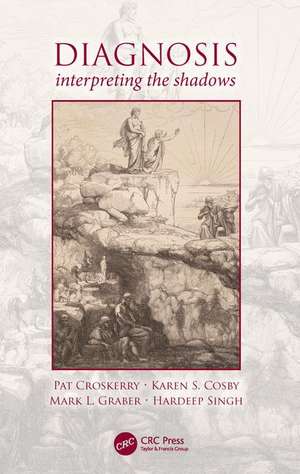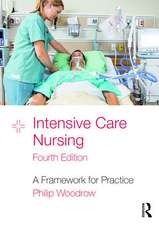Diagnosis: Interpreting the Shadows
Autor Pat Croskerry, Karen Cosby, Mark L. Graber, Hardeep Singhen Limba Engleză Paperback – 24 mai 2017
| Toate formatele și edițiile | Preț | Express |
|---|---|---|
| Paperback (1) | 454.81 lei 6-8 săpt. | |
| CRC Press – 24 mai 2017 | 454.81 lei 6-8 săpt. | |
| Hardback (1) | 1117.07 lei 6-8 săpt. | |
| CRC Press – 31 iul 2017 | 1117.07 lei 6-8 săpt. |
Preț: 454.81 lei
Nou
Puncte Express: 682
Preț estimativ în valută:
87.04€ • 94.51$ • 73.11£
87.04€ • 94.51$ • 73.11£
Carte tipărită la comandă
Livrare economică 23 aprilie-07 mai
Preluare comenzi: 021 569.72.76
Specificații
ISBN-13: 9781409432333
ISBN-10: 1409432335
Pagini: 386
Dimensiuni: 156 x 234 x 27 mm
Greutate: 0.58 kg
Ediția:1
Editura: CRC Press
Colecția CRC Press
ISBN-10: 1409432335
Pagini: 386
Dimensiuni: 156 x 234 x 27 mm
Greutate: 0.58 kg
Ediția:1
Editura: CRC Press
Colecția CRC Press
Cuprins
Preface; Section I: Models of Diagnosis; Chapter 1: What is Diagnosis?; Chapter 2: Medical Decision Making; Chapter 3: Modern Cognitive Approaches to the Diagnostic Process; Section II: Informal and Alternative Approaches to Diagnosis; Chapter 4: Alternatives to Conventional Medical Diagnosis; Chapter 5: Complementary and Alternative Medicine; Section III: The Elements of Reasoning; Chapter 6: Stone Age Minds in Modern Medicine: Ancient Footprints Everywhere; Chapter 7. Cognitive and Affective Biases, and Logical Failures; Chapter 8: The Rational Diagnostician; Chapter 9: Individual Variability in Clinical Decision Making and Diagnosis; Section IV: Challenges and Controversies in Diagnosis; Chapter 10: Diagnostic Error; Chapter 11: The Role of the Healthcare System in Diagnostic Success or Failure; Chapter 12: Do Teams Make Better Diagnoses?; Chapter 13: How Much Diagnosis Can We Afford?; Section V: The Fix; Chapter 14: Medical Education and the Diagnostic Process; Chapter 15: Cognitive Bias Mitigation: Becoming Better Diagnosticians; Chapter 16: Diagnostic Support from Information Technology; Chapter 17: What is the Patient’s Role in Diagnosis?; Appendix A. Cognitive Biases; Appendix B. Logical Fallacies; Glossary; Afterward
Notă biografică
Pat Croskerry is Professor of Emergency Medicine and in Medical Education at Dalhousie University in Halifax, Nova Scotia, Canada. He has been a contributor to the annual conference of the Society for Improvement in Diagnosis since its inception. He has published over 80 journal articles and 30 book chapters in the area of patient safety, clinical decision making and medical education reform. In 2006 he was appointed to the Board of the Canadian Patient Safety Institute, and in the same year received the Ruedy award from the Association of Faculties of Medicine of Canada for innovation in medical education. He is senior editor of Patient Safety in Emergency Medicine (2009). He was appointed Director of the new Critical Thinking Program at Dalhousie Medical School, and a Fellow of the Royal College of Physicians of Edinburgh in 2012. In 2014, he was appointed to the US Institute of Medicine Committee on Diagnostic Error in Medicine.
Karen Cosby is a senior Emergency Medicine Physician at Cook County Hospital and Associate Professor at Rush Medical School. Her career interests include medical education, clinical decision-making, and patient safety. She has chaired the Fellowship subcommittee of the Society to Improve Diagnosis in Medicine (SIDM) and the patient safety interest group for the Society for Academic Emergency Medicine (SAEM) where she led efforts to produce a curriculum for patient safety. She was a co-investigator of an AHRQ grant on diagnosis error. She has edited three textbooks (including Patient Safety in Emergency Medicine). Her contributions to patient safety include a framework for classifying factors that contribute to error in emergency medicine, and a 15-year review of patient care management problems identified in M&M reviews. Her main career focus is investigating and understanding medical failure and improving education to meet the needs of an increasingly complex healthcare system.
Mark L Graber is Professor Emeritus, Stony Brook University, a Senior Fellow at RTI University, and founder and president of the Society to Improve Diagnosis in Medicine. With Ilene Corina of Long Island, Dr Graber was the architect of "Patient Safety Awareness Week", now recognized internationally during the second week of March. He has authored over 100 peer review publications, and many foundational papers on diagnostic error. Dr Graber originated the Diagnostic Error in Medicine conference series in 2008, the journal DIAGNOSIS in 2014, and was a member of the IOM committee responsible for "Improving Diagnosis in Health Care". In 2014, he was the recipient of the National Quality Forum’s John M Eisenberg Award for Individual Achievement.
Hardeep Singh, M.D., M.P.H. is a general internist and patient safety researcher based at the Michael E. DeBakey Veterans Affairs (VA) Medical Center and Baylor College of Medicine, Houston. He leads a portfolio of federally-funded multidisciplinary research in understanding and reducing diagnostic errors in health care. In 2012, he received the AcademyHealth Alice S. Hersh New Investigator Award for high-impact research and in 2014, received the prestigious Presidential Early Career Award for Scientists and Engineers (PECASE) from President Obama for pioneering work in the field. In addition to being highlighted by major national newspapers, his work has made substantial public and health system impact by influencing national patient safety initiatives and policy reports, including those by the National Academy of Medicine (formerly the Institute of Medicine), US Department of Health and Human Services, National Quality Forum, American Medical Association, Agency for Healthcare Research and Quality, and the WHO.
Karen Cosby is a senior Emergency Medicine Physician at Cook County Hospital and Associate Professor at Rush Medical School. Her career interests include medical education, clinical decision-making, and patient safety. She has chaired the Fellowship subcommittee of the Society to Improve Diagnosis in Medicine (SIDM) and the patient safety interest group for the Society for Academic Emergency Medicine (SAEM) where she led efforts to produce a curriculum for patient safety. She was a co-investigator of an AHRQ grant on diagnosis error. She has edited three textbooks (including Patient Safety in Emergency Medicine). Her contributions to patient safety include a framework for classifying factors that contribute to error in emergency medicine, and a 15-year review of patient care management problems identified in M&M reviews. Her main career focus is investigating and understanding medical failure and improving education to meet the needs of an increasingly complex healthcare system.
Mark L Graber is Professor Emeritus, Stony Brook University, a Senior Fellow at RTI University, and founder and president of the Society to Improve Diagnosis in Medicine. With Ilene Corina of Long Island, Dr Graber was the architect of "Patient Safety Awareness Week", now recognized internationally during the second week of March. He has authored over 100 peer review publications, and many foundational papers on diagnostic error. Dr Graber originated the Diagnostic Error in Medicine conference series in 2008, the journal DIAGNOSIS in 2014, and was a member of the IOM committee responsible for "Improving Diagnosis in Health Care". In 2014, he was the recipient of the National Quality Forum’s John M Eisenberg Award for Individual Achievement.
Hardeep Singh, M.D., M.P.H. is a general internist and patient safety researcher based at the Michael E. DeBakey Veterans Affairs (VA) Medical Center and Baylor College of Medicine, Houston. He leads a portfolio of federally-funded multidisciplinary research in understanding and reducing diagnostic errors in health care. In 2012, he received the AcademyHealth Alice S. Hersh New Investigator Award for high-impact research and in 2014, received the prestigious Presidential Early Career Award for Scientists and Engineers (PECASE) from President Obama for pioneering work in the field. In addition to being highlighted by major national newspapers, his work has made substantial public and health system impact by influencing national patient safety initiatives and policy reports, including those by the National Academy of Medicine (formerly the Institute of Medicine), US Department of Health and Human Services, National Quality Forum, American Medical Association, Agency for Healthcare Research and Quality, and the WHO.
Recenzii
"This is the best writing yet by Croskerry, who has teamed up with other experts to write about the different elements that are key to the diagnostic process. This book is easy to read, and at the same time scholarly and well referenced. It offers much food for thought and really is 'must-read' for anyone interested in clinical reasoning, diagnostic decision making and how to teach medical students and doctors the HOW of thinking rather than just the WHAT."
—Nicola Cooper, Doctors.org, United Kingdom
—Nicola Cooper, Doctors.org, United Kingdom
Descriere
Despite diagnosis being the key feature of a physician's clinical performance, this is the first book that deals specifically with the topic. In recent years, however, considerable interest has been shown in this area and significant developments have occurred in two main areas: a) an awareness and increasing understanding of the critical role of clinical decision making in the process of diagnosis, and of the multiple factors that impact it, and b) a similar appreciation of the role of the healthcare system in supporting clinicians in their efforts to make accurate diagnoses. Although medicine has seen major gains in knowledge and technology over the last few decades, there is a consensus that the diagnostic failure rate remains in the order of 10-15%. This book provides an overview of the major issues in this area, in particular focusing on where the diagnostic process fails, and where improvements might be made.
























